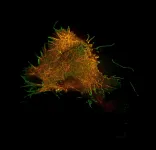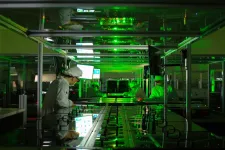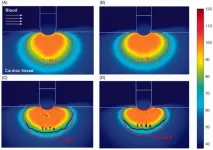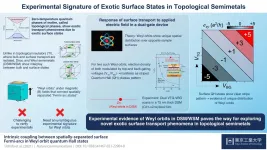(Press-News.org) The Marburg virus, a relative of the Ebola virus, causes a serious, often-fatal hemorrhagic fever. Transmitted by the African fruit bat and by direct human-to-human contact, Marburg virus disease currently has no approved vaccine or antivirals to prevent or treat it.
A team of researchers is working to change that. In a new paper in the journal Antimicrobial Agents and Chemotherapy, investigators from Penn's School of Veterinary Medicine, working together with scientists from the Fox Chase Chemical Diversity Center and the Texas Biomedical Research Institute, report encouraging results from tests of an experimental antiviral targeting Marburg virus. The compound blocks the virus from departing infected cells, thus putting the brakes on the spread of infection. Their findings are the first to show that this novel class of inhibitors can be effective against the infection in an animal model.
In addition, due to possible similarities in virus-host interactions between Marburg and SARS-CoV-2, the team has conducted experiments on the culprit behind the coronavirus pandemic. While preliminary and thus-far-unpublished, their initial tests show signs of promise.
"It really is exciting," says Ronald Harty, a co-corresponding author of the research and a professor at Penn Vet. "These viruses are quite different but may be interacting with the same host proteins to control efficient egress and spread, so our inhibitors may be able to block them both."
While many antivirals target the virus itself, the drug candidates that Harty and colleagues have been developing for years are known as "host-oriented." They prevent virus-host interactions by blocking the proteins in host cells that viruses hijack during late stages of infection.
Not only does this approach help avoid the likelihood that a virus would evolve to resist such a therapy, but it also increases the chance that a drug could be used against multiple viruses, as many rely on the same host cell machinery to reproduce and spread.
The Marburg and Ebola viruses use the VP40 protein to interact with a host protein called Nedd4 to complete the process of "budding" off a host cell. This stage of infection, which is key to viral spread, is the one the research team has targeted.
In previous studies, they had tested a variety of small molecule inhibitors of this process using laboratory tests that relied on non-infectious and more-benign viral models. Those assays helped them land on a leading candidate, FC-10696, for further study.
In the current work, they zeroed in on this candidate with rigorous evaluations. First, they tested the inhibitor to ensure it would be safe and retained long enough in the body to have an effect. Next, because the live Marburg virus is too dangerous to study safely in anything but a Biosafety Level 4 (BSL-4) laboratory, they used an assay to look at what are known as virus-like particles, or VLPs, which can bud off of a host cell like the live virus but are not infectious.
Using the Biosafety Level 2 laboratory at Penn, "it's a very quick way we can test these inhibitors," Harty says.
After seeing a dose-dependent response to FC-10696 on VLP budding in cells in a cell-culture dish, the researchers tested the compound using the real Marburg virus. These studies were done in a BSL-4 lab at Texas Biomedical Research Institute and found the compound inhibited the budding and spread of live Marburg virus in two human cell types, including in macrophages, an immune cell type commonly infected by the virus.
Finally, they evaluated the compound in mice that had been exposed to Marburg virus. Those mice treated with FC-10696 took longer to display disease symptoms and had a reduced viral load.
"These are the first promising in vivo data for our compounds," Harty says. "Whereas the control group all became sick very quickly and died, with the treated animals there was one survivor and others showed delayed onset of clinical symptoms. It's showing that our inhibitors are having an effect."
A portion of the VP40 protein in Marburg and Ebola viruses that enables budding is known as a PPxY motif. SARS-CoV-2 also happens to have this motif on its Spike (S) protein, which it uses to infect human cells. In a follow-up experiment that is not yet published, the researchers found evidence that FC-10696 was able to inhibit budding of the SARS-CoV-2 coronavirus in human lung epithelial cells.
"The SARS-CoV-2 studies are ongoing, and they're very exciting," Harty says.
INFORMATION:
Ronald N. Harty is a professor of pathobiology and microbiology in the University of Pennsylvania School of Veterinary Medicine.
Harty's coauthors were Ziying Han, Jingjing Liang, Ariel Shepley-McTaggart, and Bruce D. Freedman of Penn Vet; Hong Ye, Jay E. Wrobel, and Allen B. Reitz of the Fox Chase Chemical Diversity Center; Michael S. Saporito of Intervi, LLC; and Alison Whigham, Katrina Kavelish, and Olena Shtanko of the Texas Biomedical Research Institute. Han was first author and Harty and Shtanko were co-corresponding authors. Harty and Freedman are co-founders of Intervi, LLC.
The study was supported in part by the National Institutes of Health (grants AI138052, AI138630, AI129890, and AI070077) and an Innovator Award from The Wellcome Trust.
WASHINGTON -- Researchers have demonstrated a record-high laser pulse intensity of over 1023 W/cm2 using the petawatt laser at the Center for Relativistic Laser Science (CoReLS), Institute for Basic Science in the Republic of Korea. It took more than a decade to reach this laser intensity, which is ten times that reported by a team at the University of Michigan in 2004. These ultrahigh intensity light pulses will enable exploration of complex interactions between light and matter in ways not possible before.
The powerful laser can be used to examine phenomena believed to be responsible for ...
Recently, laser scientists at the Center for Relativistic Laser Science (CoReLS) within the Institute for Basic Science (IBS) in South Korea realized the unprecedented laser intensity of 1023 W/cm2. This has been a milestone that has been pursued for almost two decades by many laser institutes around the world.
An ultrahigh intensity laser is an important research tool in several fields of science, including those which explore novel physical phenomena occurring under extreme physical conditions. Since the demonstration of the 1022 W/cm2 intensity laser by a team at the ...
The health benefits of sardines and oily fish are widely known: their high levels of unsaturated fats help to regulate cholesterol levels and prevent the onset of cardiovascular diseases. However, the benefits don't end there. A study led by Diana Diaz Rizzolo, lecturer and researcher of the Universitat Oberta de Catalunya's (UOC) Faculty of Health Sciences and the August Pi i Sunyer Biomedical Research Institute (IDIBAPS), has discovered that the regular consumption of sardines helps to prevent the onset of type 2 diabetes. Nutrients found in high quantities in sardines - such as taurine, omega 3, calcium and vitamin D - help to protect against this disease which, according to CIBERDEM's Di@betes study, affects around 14% of the Spanish population over the ...
The published data provide additional detail of an initial analysis conducted in January, while more robust data from a complete analysis of the study was subsequently shared in March 2021.
Publication of initial primary analysis highlights cross-protection by the Novavax Covid-19 vaccine against the B.1.351 variant prevalent in South Africa during the study.
This is the first published study to show protection against mild Covid-19 caused by the B.1.351 variant circulating in South Africa.
An updated analysis of the study indicated 100% protection against severe Covid-19 due to the B.1.351 variant.
"An efficacy of 50% is sufficient to meet the World ...
UNIVERSITY PARK, Pa. -- Social media has become a platform for new mothers to openly share their experiences of the joys and challenges of parenthood. Researchers at Penn State and Dalhousie University have unraveled the sentiments in nursing mothers' tweets to better understand the factors influencing breastfeeding behaviors. They hope the findings can inform policies and interventions to support and improve resources for nursing mothers, such as breastfeeding support, workplace accommodations and technological aids such as apps.
"We are getting the raw sentiment of nursing mothers without putting them in a controlled experiment environment ...
The world's first-ever 'academic paper which is not a paper' is due to be presented by a Lancaster University research team at the premier international conference on human-computer interaction.
Dr Joseph Lindley, a researcher at Lancaster University's ImaginationLancaster design-led research laboratory, Dr Miriam Sturdee, from the University's School of Computing and Communications, Senior Research Associate Dr David Green and Research Associate Hayley Alter have been invited to take part in the 2021 ACM CHI Virtual Conference on Human Factors in Computing Systems in May.
Using the innovative 'Gather Town' online video-calling and conferencing platform, they have experimented in setting up a conference paper as an interactive but virtual ...
Clinical practice guidelines for dealing with the physical and mental health of transgender people highlight the current lack of a solid research base which must be improved, according to a new study published in the journal BMJ Open.
A team of researchers from Anglia Ruskin University (ARU) and King's College London searched world literature for all international clinical practice guidelines on the healthcare needs of gender minority and trans people.
Results showed that higher quality guidelines tended to focus mainly on HIV, and most others were on transition-related interventions. There were noticeable gaps in the topics of guidelines, with none addressing ...
An article published in International Journal of Hyperthermia proposes a more effective protocol for the treatment of cardiac arrhythmias when applying radiofrequency energy at the site of the arrhythmia by catheterization. The research results from the final year project (TFG) on the bachelor's degree in Biomedical Engineering by Sergi Coderch Navarro, supervised by Ana González Suárez and Oscar Camara, researchers with the PhySense group of the BCN MedTech Research Unit at the UPF Department of Information and Communication Technologies (DTIC). Sergi Coderch Navarro defended his TFG in July 2019 and was a runner-up in the 2019 Gemma Rossell i Romero Awards. Currently, Ana González Suárez is a postdoctoral ...
Scientists at Tokyo Institute of Technology experimentally verify the existence of exotic surface conduction states in topological semimetals (TSMs), materials that lie at the boundary between conductors and insulators, by performing voltage scans of these surface states on a thin film sample of a TSM. The findings can pave the way for future study and exploitation of such conduction states in realizing novel, quantum transport phenomena.
All of us are probably familiar with the idea of conductors and insulators. But what would you call a material that can conduct on the surface but insulate on the inside? Physicists call it a "topological insulator" (TI), a term that highlights the geometric aspect of its strange conduction behavior. Even stranger ...
ITHACA, N.Y. - Solar-power developers need to explore using lower-quality agricultural land for solar energy, incentivize dual-use (combined agriculture and solar) options, avoid concentrated solar development and engage communities early to achieve New York's green energy goals, according to forthcoming Cornell University research.
"As farmland is generally flat and cleared, agricultural land will be the prime target for future solar energy development," said Max Zhang, professor in the Sibley School of Mechanical and Aerospace Engineering. "Good farmland, however, is not ideal."
Zhang is senior author of "Strategic Land Use Analysis for Solar Energy Development in New York State," which will publish in August 2021 in Renewable Energy.
Under New York state's 2019 Climate ...






